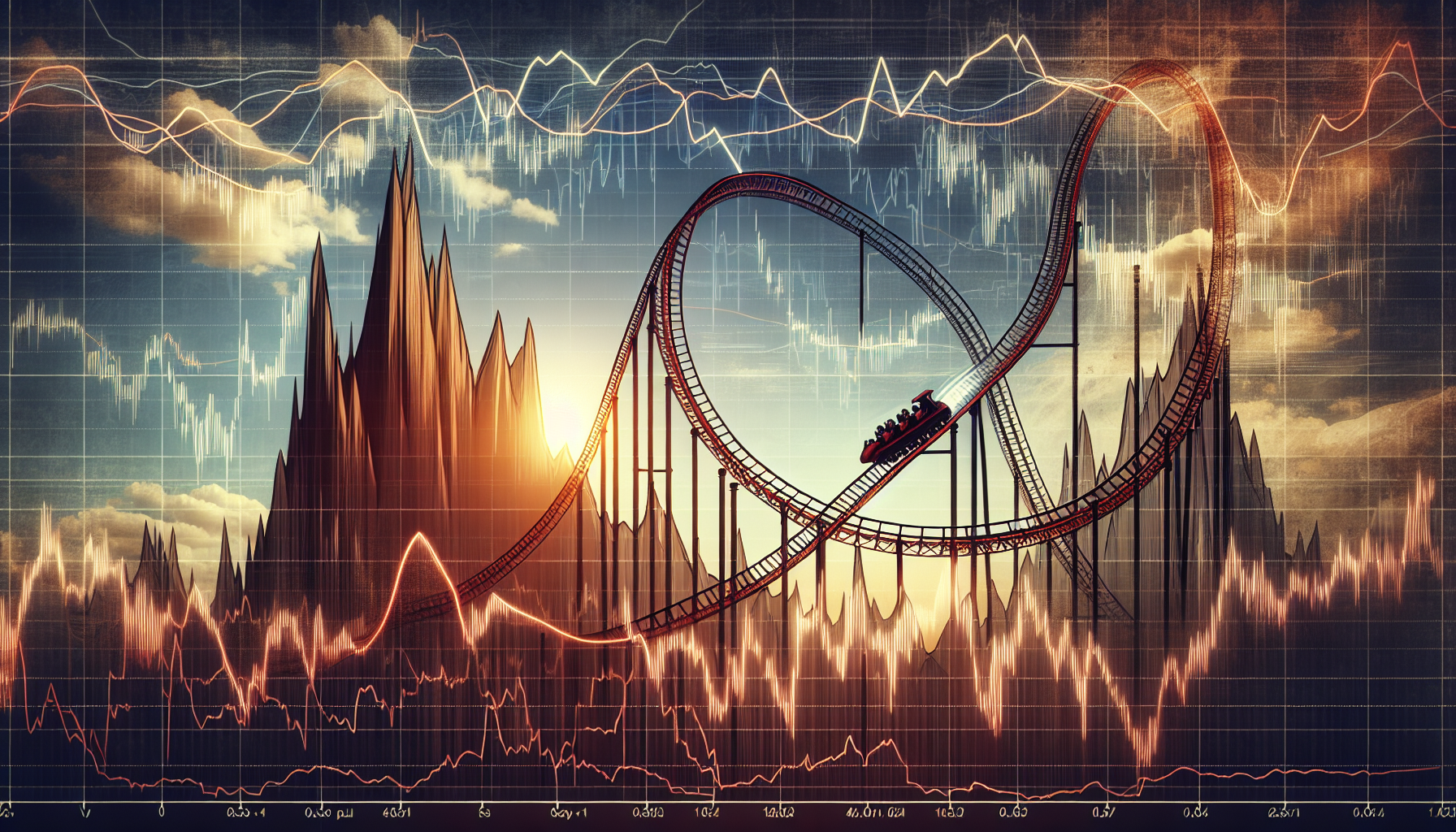
In the energizing world of trading, several concepts play a fundamental role; one of the most crucial among them is “volatility.” This article, “What is Volatility in Trading,” will guide you on an enlightening adventure into the fast-paced scene of financial markets. From defining volatility to understanding its significance in your day-to-Day Trading, this insightful piece is for you. As you unravel the mysteries of price fluctuations and market dynamics, you’ll discover the ability to make wiser and more informed trading decisions. So, buckle up, dear reader, and prepare to unearth the pivotal role of volatility in the world of trading.
Defining Volatility In Trading
When you’re new to the world of trading, you might be inundated with a host of technical terminologies that can seem quite overwhelming. One such term you’ll frequently encounter is volatility. And understanding it is crucial to your success as an investor or trader.
Basic Definition of Volatility
In layman’s terms, volatility refers to the rapidity of price changes in a market– it measures the speed and magnitude at which prices move within a specified period. It is an essential aspect of trading as it reflects the fluctuations in the price of an asset, index, or a financial instrument. High volatility implies that an asset’s price is moving significantly, indicating greater risk but also potential for higher returns. Conversely, low volatility suggests marginal price movements and potentially lower return but lower risk.
The Role of Volatility in Markets
Volatility plays a crucial role in financial markets. It’s a key indicator of market sentiment and confidence levels, reflecting economic stability or turbulence. High volatility often signifies fear, and market uncertainty, whereas low volatility can suggest contentment or complacency among investors. Remember, volatility can swing in both directions – up and down, implying that both sharp rises and decreases in prices add to market volatility.
Price Fluctuations and Market Dynamics
Price fluctuations are inherently shaped by market dynamics, and in turn, impact volatility levels. Many factors cause these market dynamics, including economic data releases, company news, geopolitical events, and systemic risk, among others. Thus, understanding how these factors influence price rhythms in the market is key to comprehending the fundamentals of volatility.
Types of Volatility
Understanding the types of volatility is essential in predicting asset price movements and risk management. Notably, traders and market analysts generally consider three types, namely, historical, implied, and relative volatility.
Historical Volatility
Historical volatility refers to the fluctuation in a financial instrument’s price over a given period. It is used as a tool to predict future movements based on past data. Traders use this as an indicator to understand how volatile an asset has been and to anticipate the potential for high or low volatility in the future.
Implied Volatility
Implied volatility is a forward-looking measure that gauges expected future volatility. It’s derived from an asset’s option price and can predict potential turns an asset’s price might take, thus preparing traders to strategize accordingly.
Relative Volatility Index (RVI)
Relative Volatility Index (RVI) is a type of measure of the market’s expectation of future volatility and reflects the direction of volatility. It is similar to the Relative Strength Index (RSI), but instead of price values, RVI uses standard deviation as its base.
Measuring Volatility
While volatility is a significant concept in trading, measuring it accurately is just as critical. Some of the most commonly used methods include volatility indexes like the VIX, Average True Range (ATR), and Bollinger Bands.
Volatility Indexes Such As VIX
The Volatility Index, commonly known as the VIX, is a real-time market index that represents the market’s expectation of 30-day forward-looking volatility. It derives its values from the prices of S&P 500 index options. Often dubbed the ‘fear gauge,’ it shoots up during periods of market turmoil and drops in relatively calm markets.
Average True Range (ATR)
Another useful volatility measurement tool is the ATR or Average True Range. An ATR indicator measures market volatility by decomposing the entire range of an asset price for that period. Essentially, it helps traders to identify the magnitude of price volatility.
Bollinger Bands
Bollinger Bands are another widely used tool to measure volatility. Essentially, Bollinger bands comprise a simple moving average (middle band), an upper band, and a lower band. These bands expand and contract based on the volatility in the market. During periods of increased volatility, the bands widen and conversely narrow down when the market is calm.

Causes of Market Volatility
Understanding what drives volatility can give you a better edge in navigating tumultuous market periods. Key triggers for market volatility typically include economic indicators and reports, geopolitical events, and market sentiment.
Economic Indicators and Reports
Economic indicators and reports, such as inflation rates, unemployment figures, or GDP reports, can significantly affect market volatility as they depict the health of an economy. These reports influence market participants’ decisions, who, in turn, shape market prices and volatility.
Geopolitical Events and Uncertainty
In today’s interconnected global economy, geopolitical events, and uncertainties–be it elections, wars, or trade disputes, can significantly influence market volatility. Generally, the global markets disdain uncertainty; thus, during times of geopolitical unrest, expect heightened volatility.
Market Sentiment
Market sentiment, or the overall mood of investors, also heavily influences market volatility. Factors affecting sentiment can include news about specific companies, sectors, or even macroeconomic news. Additionally, extreme investor emotions, such as fear or greed, can lead to price volatility.
Volatility and Market Cycles
Volatility is intrinsically linked with market cycles. Understanding how market states, like bull and bear markets, business cycles, and even seasonal factors, influence volatility can be crucial.
Bull and Bear Markets
A bull market, characterized by rising prices, usually sees reduced volatility as investor confidence is high, and market participants are eager to buy. Conversely, bear markets, marked by falling prices, typically exhibit higher volatility due to increased selling pressure and investor anxiety.
Business Cycles and Economic Conditions
Business cycles and broader economic conditions also heavily influence volatility. In duress times, like recession or economic downturn, volatility typically increases as uncertainty reigns. In contrast, during expansion phases, volatility often decreases as economic stability returns.
Seasonal and Calendar Effects
Believe it or not, even the time of year can affect market volatility. For example, the ‘October effect’ is believed to bring more market crashes than any other month, while the ‘January effect’ suggests that the market’s performance in January forecasts the trend for the rest of the year.
Volatility in Different Asset Classes
Volatility can and does occur in all asset classes, including equities (stocks), fixed income (bonds), commodities, currency markets, and even the increasingly popular cryptocurrencies. However, the degree and frequency of volatility can vary considerably from one asset class to another.
Equities (Stocks) vs. Fixed Income (Bonds)
Comparatively, equities or stocks, with their return potential, generally tend to be more volatile than fixed income assets, like bonds, which are commonly believed to be safer and offer more consistent but lower returns.
Commodities and Currency Markets
Commodity and currency markets are profoundly impacted by global economic and political events, leading to potentially high volatility levels. For example, geopolitical tensions in oil-producing countries can lead to significant fluctuations in oil prices.
Cryptocurrency Volatility
Cryptocurrencies have become famous for their extreme volatility, with prices experiencing drastic rises and falls within short periods. This volatility stems from a multitude of factors like regulatory news, market speculation, and technological updates.
Strategies for Trading Volatile Markets
While volatility introduces risks, it also presents opportunities. If approached with the right strategies, volatile markets can be favorable for trading. It all comes down to position sizing, volatility breakout strategies, and using contrarian approaches.
Position Sizing and Risk Management
Position sizing, or deciding how much to trade, is crucial in volatile markets. The key is to adjust your position size to accommodate the increased risk that comes with higher volatility. Risk management, including setting stop losses and profit targets, is equally important to protect your capital.
Volatility Breakout Strategies
Volatility breakout strategies depend on sudden jumps in volatility leading to large price movements. A trader using this strategy seeks to profit from these movements by entering the market just as the volatility spike begins.
Contrarian Trading Approaches
Contrarian trading approaches involve going against the current market trend. In high volatility situations, this can mean buying when prices have fallen dramatically (and everyone else is selling) or selling when prices have risen sharply (and everyone else is buying).
Volatility Trading Instruments
In order to trade volatility effectively, traders often turn to certain financial instruments. These include options trading, volatility index futures, and Exchange-Traded Products (ETPs) for volatility.
Options Trading
Options, contracts that offer the right (but not the obligation) to buy or sell an asset at a predetermined price on or before a specific date, can be an effective way to trade volatility. By their nature, options gain value as volatility increases and lose value as volatility decreases, making them a potentially useful tool in a volatility trading strategy.
Volatility Index Futures
Futures contracts on volatility indexes allow traders to speculate on how volatile the market will be in the future. These derivatives can be used to hedge against future fluctuations in volatility or purely speculative trades.
Exchange Traded Products (ETPs) for Volatility
ETPs, including Exchange-Traded Funds (ETFs) and Exchange-Traded Notes (ETNs), are another way to trade volatility. These products are designed to track the performance of volatility indexes and can be bought and sold like stocks on an exchange.
Impact of Leverage on Volatility
leverage is a tool that traders can use to multiply their exposure to certain financial markets. However, it’s essential to understand the relationship between leverage and volatility as it can be a double-edged sword– potentially increasing profits but also magnifying losses.
Margin Trading and Volatility
Margin trading entails borrowing funds to amplify trading positions. While margin trading can potentially aid in realizing higher profits, it also exposes traders to increased risk, especially during times of high volatility.
The Double-Edged Sword of Leverage
Leverage is indeed a double-edged sword. On the one hand, it allows traders to multiply the size of their trades, increasing the potential for profits. On the other, it exacerbates the impact of price movements, leading to larger losses if the market moves against their position.
Leverage Ratios and Volatility Exposure
The risk associated with leverage and volatility is determined by the leverage ratio, which impacts your exposure to the market. Higher leverage ratios mean higher risk, particularly in volatile markets.
Future Trends in Market Volatility
Looking ahead, the landscapes of market volatility are evolving, influenced by technological advancements, regulatory changes, and predictive tools.
Technological Advancements and Algorithmic Trading
The rise of technology and high-frequency algorithmic trading models has brought a new dimension to market volatility. Automated trading systems, capable of processing vast amounts of data and placing trades based on complex algorithms, can trigger sharp increases or decreases in price volatility.
Regulatory Changes and Their Impact
Regulatory changes can also impact market volatility. Changes in monetary policy, for instance, can trigger volatility in currency markets, while regulations affecting a particular sector can lead to increased volatility for companies within that sector.
Predicting Volatility: An Evolving Landscape
Predicting volatility is not an easy task. However, with the growing use of data analytics, artificial intelligence, and machine learning, the landscape for predicting volatility is evolving, potentially offering more sophisticated tools for traders in the future.
In summary, while volatility is an integral part of the trading equation, understanding it and knowing how to harness it is key to becoming a successful trader. It’s about understanding the risks involved, being prepared for fluctuating market conditions, and making informed decisions to capitalize on market movements. Remember, market volatility isn’t necessarily bad; it’s how you navigate through it that counts.



